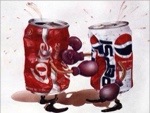
When it comes to soft drinks, Coca-Cola is king. It used to position itself as the real thing and that was a powerful brand branding strategy. Coke was the first cola to get into the market. That meant it was the original Cola – The Real Thing. Everybody wants to drink the real thing. If you are not drinking Coke, what are you drinking?
But Pepsi could prove that it actually tastes better. The Pepsi Challenge is a blind test that has been taken over 800,000 people since 1983. Of these, 60 per cent have said that Pepsi tastes better than Coke. And yet Coke still outsells Pepsi. What. People can see what they are buying, more buy Coke because they know it is the real thing. The real thing must be the best thing, regardless of what blind taste tests show.
Being better and cheaper is often a strategy that companies use to no avail when faced with competitions that can claim to be the real thing. What about using performance then? That is a strategy to differentiate a brand from other brands and it’s to make it large. You could, if the category is extremely sensitive to performance – like computer chips. But the category of soft drink is not exactly performance-sensitive, so a “higher-performance” soft drink ( meaning better-tasting ) is not really a strong differentiator.
Pepsi needed to take the Opposit position, but that posed the biggest challenge of all. The Opposite of the real thing is the fake thing. Who would want to drink the fake thing? Not us. What about you?
However, taking the opposite poison ( brand building strategy) does not always mean coming so in the literal sense. Be ingenious. This is probably the strategic thinking process that Pepsi went through to come up with one of the greatest opposite direction brand differentiation strategies ever derived:
1. Coke is the real thing. We need to take the Opposit position but we so not want to be The Fake Thing because nobody what’s to drink something like that.
2. Why is Coke real thing? Because it was the first cola in the market. And that is something that can’t be changed.
3. Being first is good but there must me drawbacks. What are some of these drawbacks? Well, for a start, being the original means that Coke is old – it was established in 1886, which means it is now more than 120 years old. That’s very old, by any standard. Never mind that Pepsi is not much younger than Coke, being first, is still grandfather of soft drinks.
4. Pepsi should admit that Coke is real thing. And Pepsi should take this further by saying that Coke is real thing because it is the old thing. It is the brand old people like your parents and their parents before them drank.
5. Finally. Pepsi should take the opposite brand position by being The Young Thing. The brand for the young generation. This will polarise the market into two Opposit camps. In the ted corner, we have Coke, which is the old thing for those senior citizens among you. In the blue corner, we have Pepsi, the young thing for the young and young-at-heart among you. Let the game begin!
